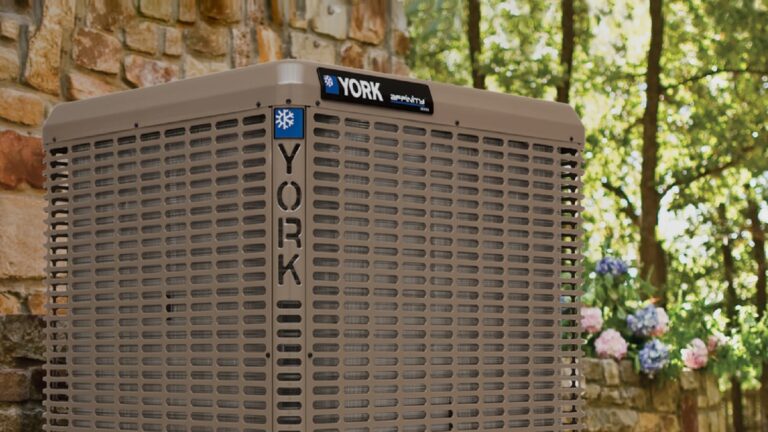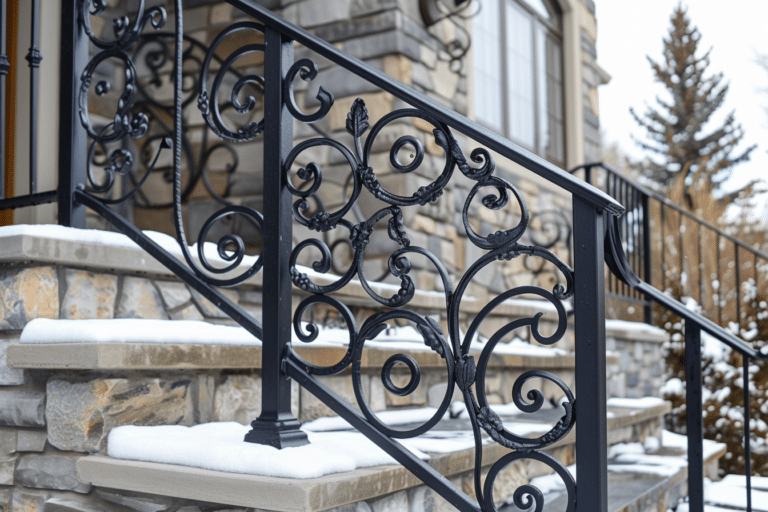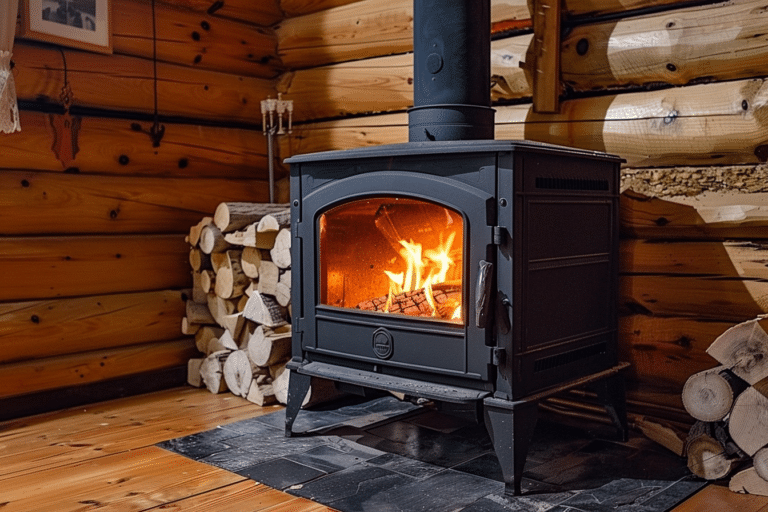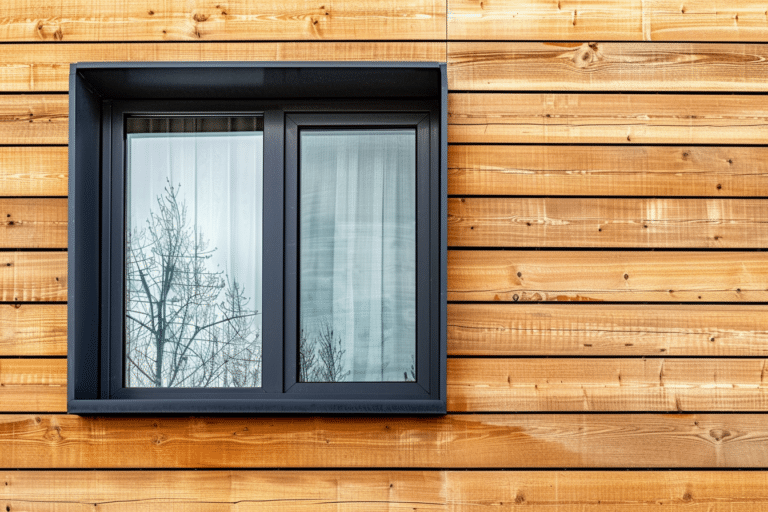| Key Takeaways | |
|---|---|
| Pellet Stove Installation | $1,600 – $4,100 |
| Wood Stove Installation | $1,200 – $4,500 |
| Fuel | Pellet stoves use pellets; wood stoves use firewood |
| Appearance | Pellet stoves have a modern design; wood stoves offer rustic charm |
| Ease of Use | Both stoves have variable ease of use but differ in maintenance and operation |
| Lifespan | Pellet stoves last 10 – 15 years; wood stoves last 10 – 20 years |
| Safety | Pellet stoves are generally safer than wood stoves |
| Environmental Concerns | Pellet stoves are eco-friendly; wood stoves can cause pollution |
$1,600 – $4,100 Pellet Stove Cost Installed
Investing in a pellet stove can cost between $1,600 and $4,100, including installation. This range accounts for the cost of the stove itself, plus any necessary installation fees. Due to the need for electricity to run certain components such as the feeder and blower, it’s essential to consider these operational requirements.
$1,200 – $4,500 Wood Stove Cost Installed
The cost of installing a wood stove can range from $1,200 to $4,500. This price variation depends on the stove’s design, size, and material, as well as installation specifics like ventilation requirements. Wood stoves do not necessarily rely on electricity, possibly reducing ongoing operational costs.
Wood Stove Vs. Pellet Stove Cost
A comparison between wood stoves and pellet stoves reveals distinct differences in cost, fuel type, appearance, lifespan, and other features.
Pellet Stove Vs. Wood Stove Comparison
| Factor | Pellet Stove | Wood Stove |
|---|---|---|
| Cost | $1,600 – $4,100 installed | $1,200 – $4,500 installed |
| Fuel | Pellets | Firewood |
| Appearance | Modern design | Rustic charm |
| Ease of Use | Variable | Variable |
| Lifespan | 10 – 15 years | 10 – 20 years |
| Safety | Safer design | Higher fire risk |
| Environmental Concerns | Eco-friendly | Potential pollution |
Pellet Stove
Pellet Stove Pros And Cons
| Pros | Cons |
|---|---|
| Efficient fuel source | Requires electricity |
| Easy to use | Maintenance required |
| Consistent heat | Limited ambiance |
| Environmentally friendly | Pellet dependency |
| Automated feeding | |
| Less ash production |
Pellet stoves offer efficient, consistent heating with ease of use and environmental benefits. However, they require electricity, have maintenance needs, and their ambiance may not match traditional wood fires.
Wood Stove
Wood Stove Pros And Cons
| Pros | Cons |
|---|---|
| Natural ambiance | Labor-intensive |
| Renewable fuel | Inconsistent heat |
| Less expensive | Requires regular cleaning |
| Radiant heat | Large firewood storage space needed |
| No electricity required | Smoke production |
| Long burn time | Air quality concerns |
Wood stoves are valued for their natural ambiance, cost-effectiveness, and renewable fuel source. However, their operation can be labor-intensive, and they pose some air quality concerns due to smoke production.
Wood Vs. Pellet Stove Comparison
To make an informed decision, let’s compare the two stove types on several critical factors.
Fuel
Pellet stoves use compressed pellets made from wood waste, promoting sustainability. They offer predictable costs and consistent burn times. Wood stoves use firewood, a renewable resource, but require cutting, splitting, and storage, making them more labor-intensive.
Appearance
Pellet stoves often feature a sleek, modern look, fitting well in contemporary homes. Wood stoves, with their rustic charm and classic designs, are ideal for traditional or country-style interiors.
Ease Of Use
Pellet stoves provide automated feeding systems, simplifying operation and reducing manual labor. Wood stoves, while offering warmth and ambiance, require frequent manual fueling, fire maintenance, and ash cleaning.
Size
Pellet stoves are generally more compact, fitting smaller spaces well. Wood stoves come in varying sizes, but larger models need substantial space for both installation and fuel storage.
Energy Efficiency
Pellet stoves are highly efficient, converting a large proportion of their fuel into heat. Wood stoves vary in efficiency, often depending on the quality of the wood and the stove design.
Installation
Both stoves require professional installation. Pellet stoves need specialized venting and an electrical connection, while wood stoves need a chimney or flue system, which can increase installation complexity and cost.
Maintenance
Pellet stoves require regular maintenance of mechanical parts, periodic ash removal, and ensuring pellet supply. Wood stoves need frequent cleaning of ash and creosote buildup, as well as maintenance of the chimney to prevent blockages and fire hazards.
Lifespan
Pellet stoves typically last 10 to 15 years, depending on usage and maintenance. Wood stoves can last longer, between 10 to 20 years, due to their simpler mechanical structure.
Safety
Pellet stoves are generally safer, with features like sealed combustion chambers reducing fire risk. Wood stoves, while effective, pose a higher risk due to open flames and creosote buildup in chimneys.
Environmental Concerns
Pellet stoves are eco-friendly, using renewable resources and producing less pollution. Wood stoves can contribute to air quality issues due to smoke and particulate matter emissions.
Pellet And Wood Stove Alternatives
If neither a pellet nor wood stove suits your needs, consider alternatives such as gas stoves, electric fireplaces, or geothermal heating. Each alternative offers distinct benefits and can cater to different preferences and requirements for home heating.
Getting Estimates From Pellet And Wood Stove Installers
When considering the installation of a pellet or wood stove, obtaining estimates from professional installers is essential. This helps in understanding the total costs, including installation, maintenance, and any additional modifications needed for your home.
Questions To Ask Installers
- What are the total costs involved, including installation and materials?
- How long will the installation process take?
- What maintenance services do you offer post-installation?
- Do you provide any warranty or guarantees on your work?
- Are there any specific home modifications required for installation?
- Can you provide references from previous customers?
- What safety measures do you follow during and after installation?
In conclusion, both pellet and wood stoves have their unique advantages and potential drawbacks. Your choice will depend on factors such as initial cost, ease of use, maintenance levels, and environmental impact. Carefully evaluate each option to find the best heating solution for your home.







